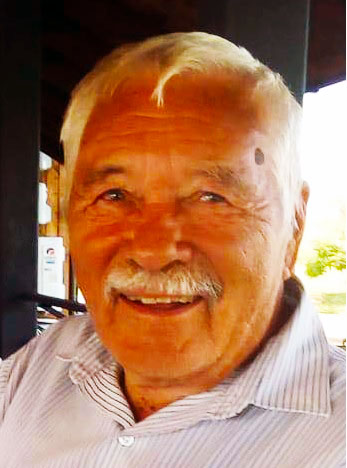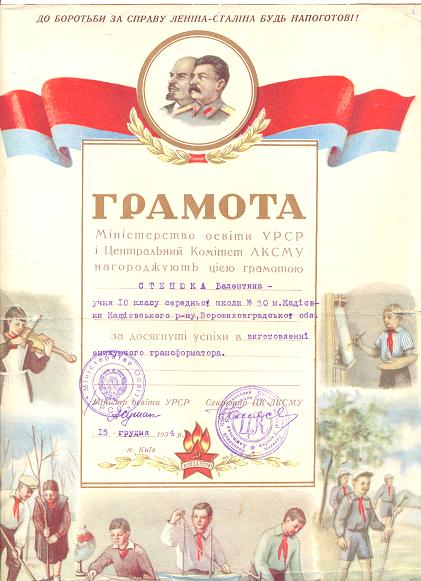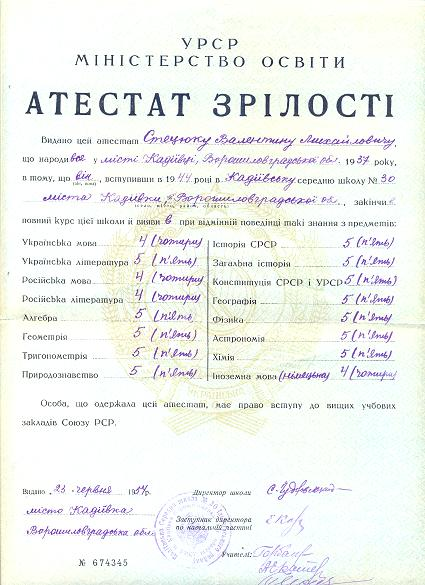Biography

The independent researcher Valentin Stetsyuk, the retired lieutenant colonel was born in the town of Sergo (now Stakhanov) Luhansk region in 1937. There is 1944, I went to school. I studied quite well in all subjects, as can be seen from the grades in my certificate of maturity. But most of all I was interested in natural sciences and history. At an average school-age my interest in history revealed a specific feature of Soviet history, which was well described already at the time when this became possible, by Makhti Dzhurtubaev as follows:
Academic science history has been in deep crisis for many reasons; but the main one was its fornication with state ideology and politics: politics changed and state historians immediately began to teach events differently (or were out of action). Therefore, honest treatment of facts and objectivity from all those involved in the study of history and culture on duty did not have to expect (DZURTUBAERV M. 2010: 830).
Realizing this feature, I never even thought about doing history professionally and chose my life path in the field of technology. I was especially interested in electrical automation, in which my father was a specialist.


Left: Diploma for the manufacture of a transformer for the exhibition of technical creativity of schoolchildren.
Right: Graduation certificate.
After graduation, I entered the Kiev Polytechnic Institute, where I studied at the Faculty of Electrical Engineering with a degree in Automation and Remote Control. In 1959 I defended my thesis project "Radioactive liquid level gauge" and in the same year I was drafted into the army with the rank of lieutenant engineer. I served in the Computing Center as system engineer in the Research Institute of Ministry of Defense. It was located in the settlement of Bolshevo (later the town of Yubileiny in the city of Korolev) in the near suburbs of Moscow.
Hoping to write a thesis on the peculiarities of computer maintenance, I passed my Ph.D. exams in philosophy and German and was preparing for an exam in my specialty, but unexpectedly for myself invented a graphic-analytical method, which made me drastically change the direction of my activity. I invented this method, comparing Slavic languages, not without the influence of Pavel Eliasberg, a professor at our institute, who was highly regarded as a mathematician. At the same time, I have been persistently studying English for four years at the state courses In-Yaz.
In 1984, I was preparing to write a dissertation on historical linguistics, but as it turned out, to defend my dissertation it was necessary to have a philological education, which I did not have. To get a second higher education in the Soviet Union, I had to have a special permit and a referral, which no one could give me. So, formally, the path to official science was closed to me, although I was still able to publish an article describing the graphic-analytical method in an academic publication. My reviewer was the well-known Kiev linguist academician O.S. Melnichuk. By a happy coincidence, F.T. Zhilko, Doctor of Philology and Professor, dwelled near Bolshevo in the town of Pushkino. In the 70s, he was accused of Ukrainian bourgeois nationalism and was dismissed for this reason from the Kyiv Institute of Linguistics. We met and corresponded regularly after my move to Lviv in 1985. He highly appreciated my article and strongly advised me to continue my research, but I went into politics for a while.
Having met several Lviv intellectuals, I tried to interest them in my method and the prospects for its use but did not find understanding. I believed in its effectiveness, so I ended my political activity in the spring of 1992 and, having transferred to the status of an independent researcher since then I have been engaged in research in the field of ethnology and comparative historical linguistics. The results of the studies were published:
1. STETSYUK V.M. 1987. Opredelenie mest poseleniya drevnikh slavian grafoanaliticheskim metodom. Izvestiya Akademii Nauk SSSR. Seriya literatury i yazyka. Tom LXIV. Nr.1. – (In Ukrainian) – The Determination of Habitats of Ancient Slavs by Graphic-Analytical method. Proceedings of the Academy of Sciences of the USSR. A Series of Literature and Language. Volume LXIV:1, Moscow.
2. STETSYUK VALENTYN. 1998. Doslidzhennya peredistorichnikh etnogenetichnikh procesiv u Skhidniy Yevropi. Persha knyga. L’viv–K. – (In Ukrainian) – The Research of Prehistoric Ethnogenetic Processes in Eastern Europe. Volume 1. Lviv–K.
3. STETSYUK V.M. 1999. Do pitannya pro etnichnu prinalezhnist’ skifiv. Zb. Arkheometriya ta okhorona istoriko-kul’turnoї spadshchini. K. – (In Ukrainian) – To the Problem of the Ethnical Origin of Scythians: Archaeomerty, 3, K.
4. STETSYUK VALENTYN. 2000. Doslidzhennya peredistorichnikh etnogenetichnikh procesiv u Skhidniy Yevropi. Druga kniga. L’viv – K. – (In Ukrainian) – Research into Prehistoric Ethnogenetic Processes in Eastern Europe, Volume 2. Lviv-K.
5. STETSYUK V. 2001. Kulturni hrona Dnistra. Multynatsionalna kulturno-istorychna spadschyna Naddnistrianschyby. Ivano-Frankivsk. Lillea. – (In Ukrainian) – Cultural bunches of the Dniestr. Multinational Cultural-Historical Heritage of the Dniestr Land. Ivano-Frankivsk. Lillea.
6. STETSYUK VALENTYN. 2002. Slidi pradavn’ogo naselennya Ukraїni v toponimitsi. L’viv. – (In Ukrainian) – The Tracks of Ancient Population of the Uktaine in Toponymy. Lviv.
7. STETSYUK VALENTYN. 2005. Samoviyav ukraintsiv i rosian v prykazkakh i prysliviakh. Ukraina vse zh taky ne Rosia. Lviv. – (In Ukrainian) – Self-expression of the Ukrainians and Russians by proverbs. Ukraine is not Russia. Lviv
8. ROTH MECHTHILD, NOBIS RALPH, STETSYUK VALENTYN, KRUHLOV IVAN (Eds). Transformation Processes in the Western Ukraine. Concept for a Sustainsble Land Use. Weißensee Verlag. Ökologie.
9. Stetsyuk Valentyn. 2006. Kürtlerin Karadenizin Kuzeyindeki Anayurdu// Karadeniz araştırmaları Dergisi,Sayı:8. (Тур. язык).
10. STETSYUK VALENTYN. 2008. Seredniy Stoh ve Yamnaya kültürleri. Akedimik bakış. Cilt 1. Sayı 2. Ankara. – (In Turkish) – The Seredniy Stoh and Pit Cultures. Akademic Look. Issue 1. Number 2. Ankara.
.11. Stetsyuk Valentyn. 2019. Reasoning on the Origin of the Human Language: Macrolinguistics. Vol.7. № 1. (Serial № 10).
.In recent years, I publish my articles on ACADEMIA
E-mail: valentyn_ua@yahoo.de.


